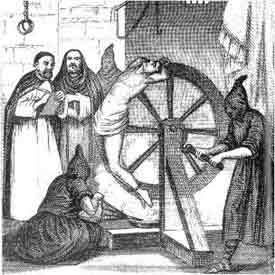Just why is it that the Vatican is now trying to tell us the Inquisition wasn't all that bad?
Now, after centuries of secrecy on the subject, the Vatican has launched a new phase in its campaign to show that the Inquisition wasn't so bad after all. Church authorities have unveiled a temporary "Rare and Precious" exhibition at Rome's Vittoriano Museum to "expose some myths" about this dark chapter of its past. The exhibit is also intended as a modern-day object lesson for governments and armies—particularly those in the United States and Europe—who torture enemies and suspected terrorists, says curator Marco Pizzo. Not only does the church have an obligation to expose its own mistakes, he says, but the exhibit is also meant to help foster understanding of the complex nature of the church's history.
[snip]
This isn't the first time that the church has tried to show that the judges of the Inquisition were not as brutal as previously believed. In 2004, the Vatican published an 800-page report claiming that of those investigated as heretics by the notorious Spanish Inquisition—which became independent of Rome in the 15th century—only 1.8 percent were actually executed. Nonetheless, Pope John Paul II famously referred to the church's 700-year campaign against heresy as a "tormented phase" and the "greatest error in the church's history". Several years earlier, he had officially cleared Galileo and said that while the Inquisition acted in good faith "they were wrong."
Really? This is the new 'transparency' the Pope is working on? So how about opening it all up to let people decide what really went on during the Inquisition? Let us see all the torture implements and the blood splattered confessions. Ok? (my bold):
The decision to finally display these intriguing elements of the church's darkest period to the general public arose from a joint effort between Vatican City and the city of Rome to reconcile Italy's complicated history and satisfy the desire for more transparency from the Catholic church. However, the artifacts on temporary display—the exhibition is being held for just a few weeks to limit damage to the delicate ancient parchments—represent only a small faction of the church's records of the period. Monsignor Alejandro Cifres of the Congregation for the Doctrine of the Faith, who co-curated the show, won't say what else is still in the archives. The pieces on display, he says, "are the most representative of the church's motives and actions." For those seeking the ultimate truth about the Inquisition, that answer is unlikely to be enough.
Ah. So much for transparency.


No comments:
Post a Comment